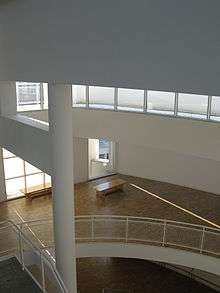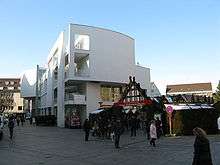Stadthaus Ulm



The Stadthaus Ulm is an assembly hall and art exhibition centre in the city centre of Ulm (Germany).
As an international landmark of modern architecture it is a building that encourages encounters with art, people, and culture. At the foot of the famous Ulm Minster, forming both a contrast and a complement to this dominating late-Gothic building, the Stadthaus and Münsterplatz (minster square) were designed by the renowned US architect Richard Meier.
History
For centuries a monastery stood in the square of today’s Stadthaus which was also used as latinschool.[1][2] It was finally dismantled in 1878 - shortly before completion of the cathedral - in order to give a free view on the worlds highest spire.[3] Thenceforth the design of Ulm’s cathedral square has been subject of heated argument for 105 years and there are records of 17 design competitions, expert opinions and design submissions.[4][5]
It wasn’t until 1986 when Richard Meier’s design was chosen and construction work began in 1991. The decision provoked discussion and hearings throughout the whole city, but in 1987 the population voted in favour of the construction in a referendum.[6] Construction was finished in 1993 and the Stadthaus opened its gates to the public. The project was completed by the design of the cathedral square. Some people were still sceptical about the architecture because they felt it wouldn't comply with that of the cathedral.[7][8]
Today the Stadthaus forms the centre of a redevelopment of Ulm’s city centre.
Architecture
The Stadthaus is experienced as one large space on different interrelated levels with a total area of 3,600 m². The open staircase connects all four levels and provides open and framed views to the interior spaces and the exterior beyond.
On the ground floor many public services are offered from behind the curved sweep of the reception counter. A permanent exhibition devoted to the archaeology and history of the cathedral square is located on the lower level. It offers a view out onto the square and is visible to passers-by.
The contrast of austerely linear and gently curving forms characterises the interior space, where architecture and art form a symbiosis. All sides of the building relate to the immediate surroundings and using Spanish Rosa Dante granite to clad the building, floor the terraces and pave the square, was a deliberate choice by Richard Meier. Additionally, the gentle incline of the roof adopts the architecture of the neighbouring buildings.
Events and exhibitions
The Stadthaus both organises and co-produces outstanding cultural projects. It has become the civic forum in Ulm for events involving visitors to the city in the fields of arts, science and scholarship, politics, business, media, and current topics of common interest to the public.
The hall seats up to 320 people and serves as concert hall, lecture hall, discussion forum and congress venue. The profile of the Stadthaus is characterised by experimental and unusual projects. High-calibre exhibitions have provided material for open debate. The exhibition programme focuses on contemporary art, including photography, as well as on architecture and environmental planning. It is a particular concern of the Stadthaus to provide a platform for young, upcoming artists.
Another central component of the Stadthaus’ concept is the annual ‘Festival für Neue Musik’ (‘Festival of contemporary music’).
Literature
- Max Stemshorn, Alexander Wetzig (Hrsgg.): Münsterplatz, ein europäischer Stadtraum im Wandel: der Ulmer Münsterplatz in Geschichte und Gegenwart. Ulm: Süddeutsche Verlagsgesellschaft, 2. Aufl. 2005, ISBN 3-88294-358-0
- Adolf Silberberger: Neugestaltung Ulmer Münsterplatz. Ulm: Süddeutsche Verlagsgesellschaft, 1993, ISBN 3-88294-195-2
- Richard Meier, E. M. Hallworth (Übers.), Anke Zeppenfeld (Übers.), Karla Nieraad (Bearb.): "Das Stadthaus hat einen besonderen Platz in meinem Herzen": Anmerkungen zum Stadthaus Ulm. Reihe: Edition Stadthaus, Bd. 1, Ulm: Stadthaus 2007, ISBN 978-3-934727-19-9
- Manfred Sack (Text), Klaus Kinold (Fotos), Axel Menges (Hrsg.), Michael Robinson (engl. Übers.): Richard Meier, Stadthaus Ulm. Reihe: Opus, Bd. 9, Stuttgart: Ed. Menges, 1994, ISBN 3-930698-09-9
- Stephan Barthelmess, International Creative Management (Hrsg.): Richard Meier - Stadthaus Ulm. Niederstotzingen: International Creative Management, 1993, ISBN 3-9803357-1-2
- Anja Göbel, Karla Nieraad, Katja Storr: Stadthaus Ulm. 2. Auflage, Ulm 2005, ISBN 978-3-934727-06-9
References
- ↑ http://www.ulm.de/sixcms/media.php/29/S-2-3-3.pdf
- ↑ http://www.ulm.de/kultur_tourismus/stadtgeschichte/.42004.3076,3963,4236,34709,42007,42004.htm Artikel auf www.ulm.de/kultur_tourismus/stadtgeschichte
- ↑ http://www.bad-bad.de/burda-museum/r_meier_ulm.htm Artikel auf bad-bad.de
- ↑ Ingrid Honold: Der Ulmer Münsterplatz: Wettbewerbe und Projekte zu seiner städtebaulichen und architektonischen Gestaltung. Dissertation Eberhard-Karls-Universität Tübingen, Institut für Architektur, Tübingen, 1993
- ↑ Stadthaus am Ulmer Münsterplatz. In: archINFORM. used on 11. March 2010
- ↑ Stadt Ulm (Hrsg.): Münsterplatz - Bürgerentscheid am 20.9.87. Reihe: Stadt Ulm. Information, Ulm: Stadt, 1987
- ↑ Mirjam Roller: Diskussionen und Akzeptanz der Neugestaltung des Ulmer Münsterplatzes. Reihe: Blaubeurer geographische Hefte, 10, Blaubeuren: Denkhaus, 1996, ISBN 3-930998-10-6
- ↑ Mathias Schreiber: Meiers Milch. Das Ulmer Stadthaus von Richard Meier, einst Anlaß einer Bürgerrevolte, wird diese Woche eingeweiht - Bau-Frevel am berühmten Münsterturm? in: DER SPIEGEL (1993) Nr.45, S.246, 248. ISSN 0038-7452
External links
Coordinates: 48°23′53″N 9°59′27″E / 48.39806°N 9.99083°E